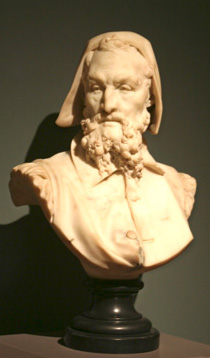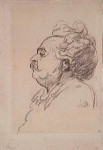

Albert-Ernest Carrier-Belluse
French, 1824-1887
Bust of Michelangelo, 1855
marble, white
18 1/2 x 16 1/2 x 9 1/2 in.
SBMA, Museum purchase, Deaccessioning funds from gifts of Joanne and Robert Kendall and Mrs. Courtney HNutton
1990.32

Portrait of Albert-Ernest Carrier-Belleuse by Daumier Honoré
RESEARCH PAPER
The glistening white marble "Bust of Michelangelo" measures 18 ½" high by 16 1/2" wide by 9 1/2" deep without its base exemplifies the talent of Albert Ernest Carrier-Belleuse to capture the ph ysiclal likeness of his subject and then to fill it out with its character. This bust's crisp, detailed, and deeply modeled face and head reflect the strong influence of Belleuses'searly training as a goldsmith and then his experience in the decorative arts at the Minton China Works. The close fitting cap that flares away from the ears and face produces shadows that emphasize the hollow, sagging, aged-cheeks and the deep pensive eyes that stare acceptingly off into the future. Even the slightly askew, broken nose doesn't detract from the nobility Carrier-Belleuse portrayed in this bust.
Carrier-Belleuse was a Frenchman born with not only an enormous artistic gift, but also and a driving entrepeneurship that thrived during the two decades of prosperity in the Second Empire of Louis Napoleon (1852-1870). Carrier-Belleuse worked as Chief Designer for the Minton China Works in England (1852-1855). After he returned to France, he quickly established hinself as one of the most talented, prolific, and sought-after artists in Paris. He established a large atelier and engaged apprentices, among them Rodin, Dalou, and Falguiere. To avoid dependence upon patronage from sales at Salons, he sold independently at auctions at the Salles Drouot in 1868. He derived a style that combined the naturalistic style of the 18 th century sculptors like Houcon and Clodion with the New Roccoco or Mannerist style with elaborate details that are evident in the curled beard and coiffure on the "Bust of Michelangelo".
In 1855, Carrier-Belleuse made a pair of two-foot tall bronze statuettes--one of a youthful Raphael and the other of a aged Michelangelo(now in the Berlin Dahlem). Each is envelped in a cape and descending stairs while in deep thought. The recent Carrier-Belleuse biographer June Ellen Hargrove is quoted, "Similar but not duplicate portraits were also done in bust form in the 1860's." (Romantics to Rodin, p 161). The signature A CARRIER across the bust's back was used only until 1868 when he expanded it to A CARRIER-BELLEUSE (Ibid p 160). Little is known of the provenance of our "Bust of Michelangelo", but we know that it most recently resided with a small collector in Paris before it reached the Yates Gallery in New York. The Metropolitan Museum has another version in silver-plated bronze, and a full-figure bronze of Michelangelo is now owned by the Louvre. Another similar terracotta bust, that of Bartolome-Esteban Murillo, uses the same technique of curled hair around the face to expertly frame the portrayed artist's distinctive features. Here, too Carrier-Belleuse added the casual turned-up collar.
The "Bust of Michelangelo" was produced early in Carrier-Belleuse's career of creating larger works. Until that time, he primarily had been producing designs for the industrial arts, for jewelry and small figures for clocks, plates, pitchers, cases, and almost anything else that could be decorated by human figures. The exact model for his Michelangelo is not certain. Perhaps he encountered an engraving of the bronze bust of Michelangelo done by Daniel Da Volterra from a death mask he had made of his beloved friend and teacher. From that bust Carrier-Belleuse could have visualized the face which Vasari, a Michelangelo biographer, described: "His face was round, the brow square and spacious, with seven straight lines, and the temples projected considerably beyond the ears; which ears were somewhat on the large side, and stood out from the cheeks ...the nose somewhat flattened; having been broken, as was said, by Torrigiano; the eyes rather on the small side of the color of horn, spotted with bluish and yellowish gleams; the eyebrows with few hairs, the lips thin, with the lower lip rather thicker and projecting a little, the chin well shaped and in proportion with the rest, the hair black, but mingled with white hairs, like the beard, which was not very long, forked, and not very thick." (Vasari, pp 395-396). Seeking realism, Carrier-Belleuse explored the face's physiogamy and revealed the man's character. He chiseled intricate details to portray elegance, but then left a jacket button undone to provide a touch or humanity-perfect imperfection.
Three particular parts (symbols) of this bust give rise to questions in my mind regarding the iconography--the cap, the forked beard, and the black streaks in the marble in the lower coat portion. Carrier-Belleuse showed little to no interest in involvement in social, political, or psychological issues. As a matter of fact, two of his trips abroad coincided with political upheavals in France, so he went to live first at Trent on Stoke and later to Brussels during those times. The following are my own deductions:
The cap that Carrier-Belleuse put on Michelangelo called a coif, was part of the ecclesiastic headwear from the 12th to 16th century, usually worn by popes, then later as a sign of rank among laymen. It was usually a fillet of white wool with long lappets. (Wilcox, p 27-31). Did this cap indicate that the church/popes were usually over/on his head, forcing him to paint when he considered himself a sculptor? Since Michelangelo was a devout Catholic seeking his salvation, did this cap symbolize his devotion, obedience, and submission to the Church's will? Or was this cap just a convenient way for Carrier-Belleuse to add depth and shadow around the face?
That Michelangelo chose to wear the unusually shaped forked beard, after the old Saxon fashion, led me to wonder about it. Pope Gregory XIV (1535-1591) also wore a forked beard (Reynolds). Is the split beard a symbol for some duality in Michelangelo's life--painter/sculptor, married to his art/married to his Church, heterosexual/homosexual?
If Carrier-Belleuse was so meticulous about detail, why didn't he work the black streaks of the marble into the fabric or texture of the coat? Did he intend to imply that they were careless paint smudges on the old painter's clothes?
The "Bust of Michelangelo " is typical of the work of Carrier-Belleuse. He was a prolific designer, and from his atelier a great number of works were produced in virtually every technique and medium used at that time. From this large studio similar editions of the "Bust of Michelangelo" were produced in terracotta, marble, and bronze. "Artisans commonly executed the creations of the "artist" in the final medium. During his youthful apprenticeships with goldsmiths, Carrier-Belleuse may have chased some of his early bronzes, but he never carved his own marbles--no one did." (Hargrove, p 246). He did supervise, direct, and put finishing touches to the works that left his studio, even if he had left it to another artist to realize his original ideas. He created so many lovely things with joy and facility. "Carrier-Belleuse might be paralleled to Jules Offenbach, the composer of light opera who wrote at an equally prolific rate. Both sculptor and composer were hailed during their lifetimes and quickly forgotten after their deaths." (Hargrove, p 304).
Prepared for the Santa Barbara Museum of Art Docent Council by Eunice Drell April 1991.
BIBLIOGRAPHY
Coughlan, Robert, The World of Michelangelo--1475-1564 , Editors of Time Life Books, New York, 1966
Fine Arts Museum of San Francisco, Rodin's Sculpture , Caso, J. and Sanders, P., Charles Tuttle Co. Inc., Vermont & Japan, 1977
Gardner, Helen, Gardner's Art Through the Ages , 6th Ed., Harcourt, New York, 1975
Hargrove, June Ellen, The Life and Work of Albert Carrier-Belleuse, (PhD Dissertation NYU 1975), Garland, London, 1977
J.B. Speed Art Museum, Nineteenth Century French Sculpture: Monuments for the Middle Class" , Lucet Charles, Louisville, Kentucky, Nov. 2 to Dec. 5, 1971
New Encyclopedia Brittanica, Macropaedia, Volume 12 , Encyclopedia Brittanica Inc., William & Hellen Benton, Chicago, 1974, p 100F
Reynolds, Reginald, Beards , Doubleday & Co., Garden City, N.Y., 1950
Vasari, Giorgio, Lives of the Most Eminent Painters, Sculptors, and Architects, (abridged from translation by Gaston Duc DeVere), The Modern Library, New York, 1959, pp 395-396
Wilcox, R. Turner, The Mode in Hats and Headdress , Scribner's and Sons, New York, 1945, pp 27-31)
Prepared for the SBMA website 2008 LG.

Bust of sculptor Albert-Ernest Carrier-Belleuse by Auguste Rodin, 1882
